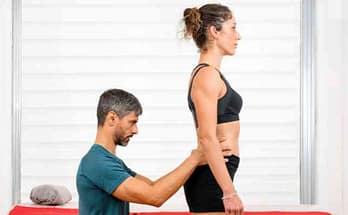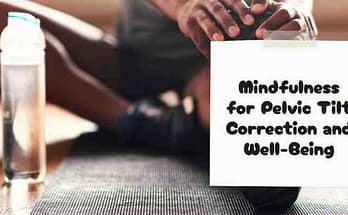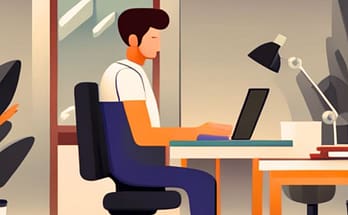Chronic lower back pain, hip pain, and knee pain can be a sign of anterior pelvic tilt (APT). APT is a condition that occurs when the pelvis tilts forward, throwing off your center of gravity and causing a host of issues.
Massage therapy has been proven to help correct anterior pelvic tilt and relieve its symptoms. From deep tissue massage to self-massage techniques, we’ll show you how massage can help correct APT and improve your overall well-being.
Keep reading to learn more and take the first step towards a pain-free life.
Key Takeaways
- APT is a condition that causes pain in the lower back, hips, and knees because of an excessively tilted pelvis.
- Common causes include poor posture, muscle imbalances, and prolonged sitting.
- Massage therapy can help alleviate many symptoms associated with APT by releasing tight muscles, stimulating weak ones, and improving blood flow.
- Techniques like Myofascial Release, Trigger Point Therapy, and Sports Massage can target specific areas of tension in the body. Self-massage is another easy way to treat muscle pain.
- Make regular stretching and exercise part of your lifestyle for lasting relief and get advice from a medical professional and qualified massage therapist about the best techniques.
- Don’t let APT control your life any longer! Take control and start feeling better today by booking a massage therapy session or incorporating self-massage techniques into your routine.
Understanding Anterior Pelvic Tilt (APT)
An anterior pelvic tilt is a postural imbalance when the front of the pelvis tilts forward and the back of the pelvis tilts backward, which causes the lower back to arch excessively and the abdomen to protrude, giving the appearance of a “butt stick” or “swayback.”
The cause of anterior pelvic tilt is a combination of muscle imbalances, poor posture, and prolonged sitting. Tight hip flexors, hamstrings, and abdominal muscles can pull the pelvis forward, while weak glutes and lower back muscles can’t effectively counterbalance this pull. Prolonged sitting can also cause the hip flexors and abdominal muscles to shorten, leading to APT.
Poor posture affects how you look, throws off your center of gravity, and can lead to other problems. It can cause lower back pain, hip pain, knee pain, headaches, and even fatigue. Poor posture also strains the muscles, ligaments, and joints in the lower back, hips, and knees.
Massage therapy can be a powerful tool in treating APT and reducing symptoms. By releasing tight muscles and stimulating weak ones, massage therapy helps to realign the pelvis and improve posture. Techniques such as Myofascial Release, Trigger Point Therapy, Sports Massage, and self-massage can target specific areas of tension and help to release tight hip flexors, hamstrings, and lower back muscles.
Additionally, massage therapy can be used as a complementary treatment and other therapies to help alleviate pain and discomfort caused by APT.
How is Massage Therapy Useful in Correcting APT?
Massage therapy effectively treats and prevents the symptoms associated with both anterior and posterior pelvic tilt issues.
Massage helps to relax tight muscles, improve flexibility and mobility, increase blood flow throughout the body and relieve pain.
A tight muscle or joint in your body puts pressure on surrounding muscles, nerves, and tendons, which can cause pain and inflammation.
Massage therapy aims to release this tension in the body so that all systems function more efficiently again.
Sitting at a desk in front of a computer screen can cause stiffness and soreness in your body. Massage helps to relieve the strain on certain areas of your back caused by prolonged sitting.
Additionally, massage increases circulation, which allows oxygenated blood to flow throughout your entire body, including areas such as your fingers and toes that don’t get enough oxygen when we’re sedentary for extended periods (like when we’re working at our desks).
One hour spent getting a regular massage can increase how much energy you have throughout each day!
Massage as an Alternative Treatment for APT
If you are suffering from anterior pelvic tilt, massage therapy can relieve your symptoms using the power of touch and a holistic approach. A trained massage therapist will work toward getting your muscles relaxed, which will help to improve your posture and reduce tension in other areas of your body.
A holistic approach to massage therapy will help you feel less pain or stress caused by APT and will help you lead a healthier lifestyle.
Massage Techniques for Correcting Anterior Pelvic Tilt
To correct anterior pelvic tilt, you can use a variety of massage techniques that target the specific muscles causing the imbalance. These techniques can help release tension in tight muscles and stimulate weak muscles, leading to improved posture and reduced pain. Some examples of massage techniques to correct APT include:
- Myofascial Release: With this technique, you apply gentle, sustained pressure to the connective tissue that surrounds muscles. It can be effective for releasing tight hamstrings, hip flexors, and many other areas of tension in the body.
- Trigger Point Therapy: This technique can help release specific tension points within the muscles. It is beneficial for releasing tight hip flexors and lower back muscles.
- Sports Massage: This technique is designed for athletes and can be beneficial for releasing tight hip flexors and lower back muscles.
- Deep Tissue Massage: This technique uses firm pressure to release tension in deep muscle layers. It can help release the psoas muscle, which is often tight in people with APT and other low-back pain problems.
- Self-massage Techniques: Self-massage with a tennis ball, exercise ball, or foam roller can help you to target specific muscle groups.
The most effective massage technique varies from person to person, so it’s important to consult a medical professional or a qualified massage therapist to determine the best methods for you.
Self-Massage Techniques
Massage can be relaxing, and it will also help you with your posture. The self-massage techniques outlined here are beneficial if you have anterior pelvic tilt.
Self-massage is a great way to combat APT and maintain good posture. Self-massage can be done at home or in the office with few materials. A tennis ball, an exercise ball (Swiss ball), or a foam roller are all great tools for self-massage!
Many types of self-massage can help alleviate the symptoms of anterior pelvic tilt, including using a tennis ball to roll out tight hip flexors or an exercise ball (Swiss ball) to roll out tight lower back muscles. Incorporating these simple exercises into your daily routine will keep good posture and prevent APT recurrences.
Stretching and Exercise for APT Prevention
Exercise and stretching are vital in preventing and correcting anterior pelvic tilt. By targeting the muscles contributing to APT, exercise can help improve your posture to reduce pain or injury.
It’s essential to include a plank exercise in your exercise routine. The plank works the core muscles, which help to support your spine and maintain proper alignment. To perform the plank, start on your hands and knees, then straighten your arms and legs so that your body is straight. Hold this position for as long as possible, working up to holding the plank for one minute or more.
The bird dog is an effective core-strengthening exercise that works the back, glutes, and pelvis to stabilize your spine. To perform this move, start on all fours, extend one arm and opposite leg to be parallel, and hold for a few seconds before switching sides.
Clamshells and bridges are also great exercises for strengthening the glutes, a muscle that is often weak in those with APT. To perform clamshells, lie on your side with your legs bent at a 90-degree angle and your top knee lifted as high as possible. To perform bridges, lie on your back with your knees bent and feet flat on the floor, then lift your hips towards the ceiling.
Add stretching to your exercise routine to help prevent anterior pelvic tilt. Stretching the hip flexors, hamstrings, and lower back can improve flexibility and reduce tension. A good stretch for the hip flexors is the lunge stretch, where you step forward with one foot and bend the knee while keeping the back leg straight. A good stretch for the hamstrings is the seated forward bend, where you sit on the floor with your legs straight out in front of you and reach forward to touch your toes.
It is best to perform stretching after warming up the muscles and before exercise.
Prevention and Management of APT
Anterior pelvic tilt can be a chronic condition, and it’s important to correct the problem and prevent its recurrence. Incorporating regular exercise and stretching into your daily routine is an effective way of preventing APT. Here are some exercises and stretches that will help:
- Strengthening exercises for the glutes and core: Exercises like squats, deadlifts, and planks can strengthen the muscles that support the pelvis and lower back
- Stretching exercises for the hip flexors and hamstrings: Tight hip flexors and hamstrings are common contributors to APT, but stretches like the lunge stretch, seated forward bend, or standing hamstring stretch can help loosen these muscles and promote better posture.
- Yoga poses: Yoga poses such as the downward-facing dog and child’s pose can help stretch back muscles and hips, promoting better alignment.
- Foam rolling: Using a foam roller to massage your muscles can help release tension and improve mobility.
Good posture can help you avoid injury and feel more comfortable during daily activities, such as sitting and standing. Sit with your feet flat on the floor, your shoulders back, and your head up. Take regular breaks from prolonged sitting, stand up and move around every hour.
Consult with a medical professional and a qualified massage therapist to determine the best techniques for you. Remember that massage therapy can be a powerful tool in correcting APT and relieving its symptoms. You can keep anterior pelvic tilt from recurring with regular exercise and stretching, good posture habits, and massage therapy.
It may take time and effort to correct APT. Still, with the right combination of exercises and stretches, you can achieve a neutral pelvic position, reduce pain and discomfort, and improve your overall well-being.
Tips for Overcoming APT
It’s important to avoid sitting for extended periods. If you sit, ensure that your muscles remain stretched out and relaxed.
If you have APT and want to progress toward correcting it, strengthen your core muscles with regular exercise (such as Pilates).
Regular exercise can help you feel less stressed, happier, and more relaxed. All of these things can contribute to better posture over time.
To reduce your risk of developing bad posture, eat plenty of whole foods like vegetables, fruits, and whole grains. These foods are rich in nutrients like vitamin D (which helps keep bones strong), calcium (which strengthens joints), iron (which helps carry oxygen throughout the body), and magnesium (which is necessary for muscle contraction). Eating these foods will also help balance blood sugar levels, so they aren’t spiking or crashing after meals—another critical factor in maintaining good posture over time!
Finally, remember to get regular massage therapy sessions! Massage therapy can have many benefits when it comes down to reducing back pain caused by APT—improving circulation while relaxing at the same time.
Massage therapy can often improve anterior pelvic tilt, a condition that causes pain and discomfort in the lower back, hips, and knees. From deep tissue massage to self-massage techniques, you can take control of your APT and improve your overall well-being by relieving pain and increasing mobility.
Book a massage therapy session with a qualified therapist today to address your APT and start on the path to a healthier, pain-free life. Remember, it is always important to consult a medical professional and a qualified massage therapist to determine the best techniques.




